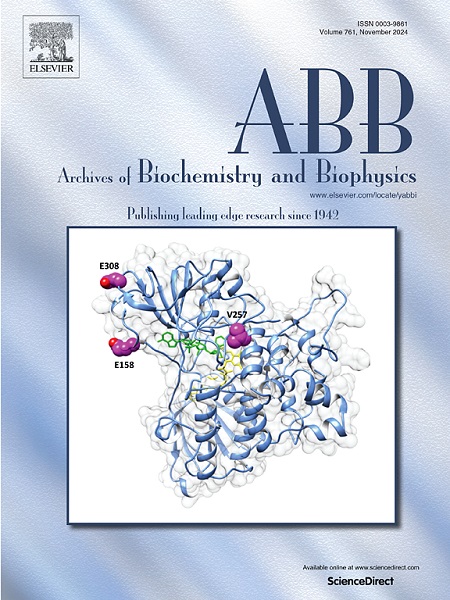食物来源的生物活性色素藻蓝胆素与SARS-CoV-2刺突蛋白共价和非共价结合,影响其构象和功能
IF 3.8
3区 生物学
Q2 BIOCHEMISTRY & MOLECULAR BIOLOGY
引用次数: 0
摘要
藻蓝胆素(PCB)是螺旋藻藻蓝蛋白的四吡啶类发色团,是胆红素类似物和弱硫醇改性剂。SARS-CoV-2刺突蛋白(SP)具有胆红素结合袋,缺乏游离巯基,但具有两对功能重要的半稳定二硫化物,对巯基修饰剂有反应。我们研究了PCB与SP及其受体结合域(RBD)的共价和非共价结合,以及PCB与RBD的共价结合对结构和与人血管紧张素转换酶2 (ACE-2)结合的影响。PCB对SP具有高亲和力(Ka = 2.1 × 107 M−1),对RBD具有中等亲和力(Ka = 8.4 × 104 M−1),并与SP和RBD共价结合。PCB结合改变RBD构象。分子对接鉴定出PCB与SP的两个结合位点,胆红素/胆绿素结合位点和RBD的疏水袋,位于PCB与RBD硅共价对接的优先共价结合靶点Cys432附近。氧化还原蛋白质组学在RBD中定位了反应性的Cys432、Cys391和Cys525。pcb修饰的RBD与ACE-2的结合能力降低。这是首次证明PCB对缺乏游离巯基的蛋白质的半稳定二硫化物具有反应性的研究。PCB可能通过非共价和共价结合影响SP及其RBD的功能和结构。本文章由计算机程序翻译,如有差异,请以英文原文为准。
Food-derived bioactive pigment phycocyanobilin binds to SARS-CoV-2 spike protein both covalently and noncovalently affecting its conformation and functionality
Phycocyanobilin (PCB), tetrapyrrole chromophore of Spirulina phycocyanin, is bilirubin analog and weak thiol-modifying agent. SARS-CoV-2 spike protein (SP) has bilirubin binding pocket, lacks free sulfhydryl, but it has two pairs of functionally important semi-stable disulfides reactive towards thiol-modifying agents. We investigated covalent and noncovalent binding of PCB to SP and its receptor-binding domain (RBD) and impact of covalent PCB conjugation to RBD on structure and binding to human angiotensin-converting enzyme 2 (ACE-2). PCB shows high-affinity for SP (Ka = 2.1 × 107 M−1), moderate-affinity for RBD (Ka = 8.4 × 104 M−1) and binds covalently to SP and RBD in reaction involving thiols. PCB binding alters RBD conformation. Molecular docking identified two binding sites of PCB to SP, bilirubin/biliverdin binding site and hydrophobic pocket of RBD in vicinity of Cys432, preferential target for covalent binding in in silico covalent docking of PCB to RBD. Redox proteomics mapped reactive Cys432, Cys391 and Cys525 in RBD. PCB-modified RBD exhibited reduced ability to bind to ACE-2. This is the first study demonstrating PCB reactivity towards semi-stable disulfides of proteins lacking free sulfhydryl groups. PCB may affect functionality and structure of SP and its RBD by noncovalent and covalent binding.
求助全文
通过发布文献求助,成功后即可免费获取论文全文。
去求助
来源期刊

Archives of biochemistry and biophysics
生物-生化与分子生物学
CiteScore
7.40
自引率
0.00%
发文量
245
审稿时长
26 days
期刊介绍:
Archives of Biochemistry and Biophysics publishes quality original articles and reviews in the developing areas of biochemistry and biophysics.
Research Areas Include:
• Enzyme and protein structure, function, regulation. Folding, turnover, and post-translational processing
• Biological oxidations, free radical reactions, redox signaling, oxygenases, P450 reactions
• Signal transduction, receptors, membrane transport, intracellular signals. Cellular and integrated metabolism.
 求助内容:
求助内容: 应助结果提醒方式:
应助结果提醒方式:


